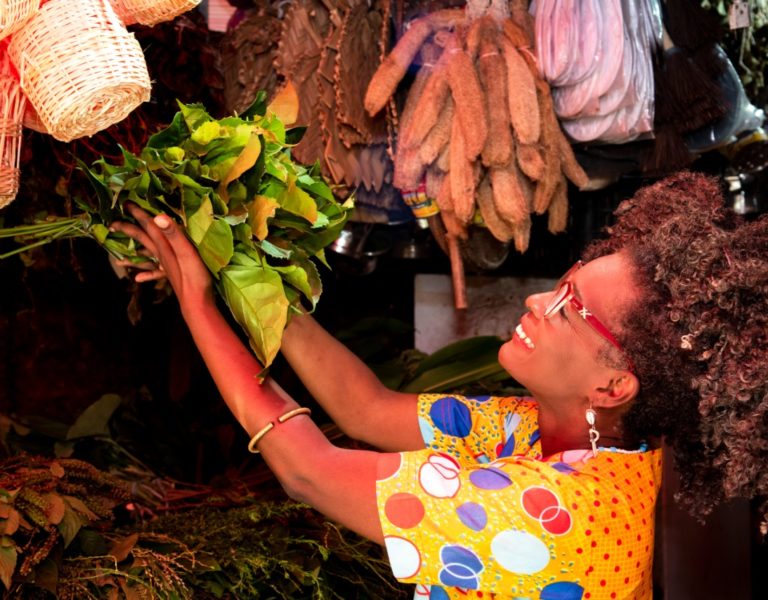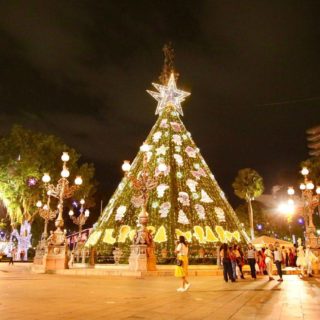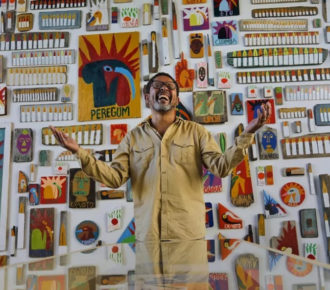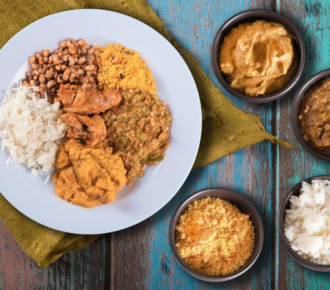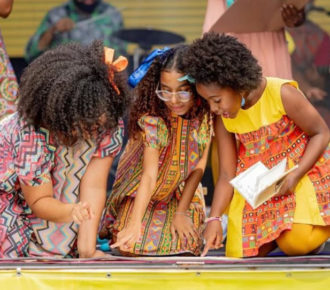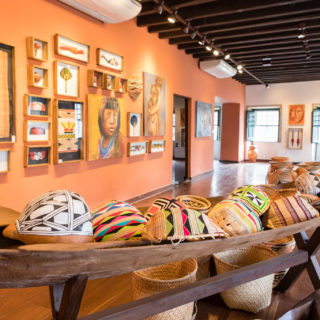
Understand how phytoenergetic therapies and rituals can help with physical and emotional balance
By Meire Oliveira
Very associated with rites in religions of African origin – Kosí Ewé, Kosí Orixá (no leaf, no orixá) – the leaf bath acts in the physical, mental and spiritual spheres and integrates the formative legacy of Bahian cultural identity. And yes, it is possible, regardless of your religious belief, to obtain the benefits of phytoenergy (leaf energy) promoting balance and attracting the vibration you want. We have entered this universe, and you will learn how to prepare baths, harmonize your home, self-care tips, in addition to knowing points of sale and indications of books and movies on the subject.
Focusing on the mixture of these elements in the water for the bath, the main benefit is to potentiate the energies that we want to bring to our life. Thus, spiritual cleansing, prosperity, protection, calm and vital energy are on the list of the most common requests in this self-care rite. As the song “Banho de Folha” (Luedji Luna and Emillie Lapa) says, “A handful of sacred leaves / To heal me, to keep me away from all evil”.
And as the biologist and PhD in Environmental Development Sueli Conceição explains, it is necessary to establish a connection right at the beginning of the process.
“It is necessary to establish a relationship with the energy that is being sought in the plant, which is a living being and will provide this balance. Therefore, it is essential to assume your responsibility in this healing process”, said the specialist.
Care
Religious use follows a series of criteria that range from determining what will be used, depending on the objective and orixá related to the process, through the specific person who can remove the leaves in nature, to the protocol to be followed in the preparation of the bath, among others. In this scenario, the orixá Ossain holds the power to awaken the therapeutic virtues of plants that heal in the physical and spiritual plane. In this sense, the indications throughout this text do not compromise the energy field of those who make use of these elements of nature.
However, using these elements dissociated from the sacred bias does not dispense care which contributes to the success of the procedure. Preferably use fresh or dried flowers and herbs. If you have the opportunity to pick the leaf in its natural environment, say it out loud.
“Ask permission to handle it, thank it, say why you are doing it and that you need to rely on the energy of that living being for what you want”, guides Sueli, who is also a Candomblé religious.
The morning is the best time to remove the leaves, since the bioactive principles are more latent, before 9 am, when the sun is hottest. Then, the advice is to let the leaf rest for 4 to 6 hours to recover from the stress caused by the removal.
“Be careful to harvest only the leaves, and not the stem, to make it possible for the plant to regenerate”, explains the biologist.
For those who are going to buy the leaves at fairs or markets, observation is the best ally. Packaging and appearance must be taken into account. “Places where the constant handling of passersby is allowed, testify against the healing process, not to mention the appearance that can reveal the state of putrefaction”, explains Sueli, who is also the founder of Iya Omi natural cosmetics, which will launch a course on guidance on the correct use of herbs in a phytoenergetics context, in July.
Valuable tips
1 Before use, the leaves purchased at fairs must be sanitized in a solution with apple cider vinegar (one teaspoon to 1 l of water) and hung to dry in an area that alternates shade and sun.
2 There are two most common preparations for baths: maceration (extraction of the juice by rubbing the leaves with your hands in water) and tea. In the first one, as the contact with the plant lasts longer, it makes it possible to “talk” about what is desired with that use.
3 For intentions focused on awakening and activation, the ideal is a cold bath. As for relaxation and sleep, the warm temperature is more indicated.
4 Last but not least, take a regular bath before the bath that will promote this magical encounter in your self-care rite.
Your body and home in full harmony
After taking care of the body, it’s time to take care of your house. The space of your residence must also be kept in balance. “It is the place where we recharge our energies, we work, and it must be prepared”, explains the specialist. Pitanga leaves, aroeira and São Gonçalinho balance the environment and call prosperity, happiness. “The water with these macerated leaves can also be used to wash the floor of the house, to pass a cloth. The dehydrated ones, along with the rosemary, can be placed in the incense”, says Sueli.
If the bouquets are going to be put in vases, we can focus on each environment. Lavender, lemon balm and rosemary for resting places like the bedroom. The home office room needs concentration and harmonization, provided by rosemary and patchouli. The energy of love is drawn to rose petals and patchouli. Pepper, male rue and large basil ward off bad energies at work. At the door of the house, it’s good to have the “espada de Ogun” (snake plant) and “comigo-ninguém-pode” (dumb cane) counter negative energies.
Recipes: learn how to make some leaf and herb baths
Restorative sleep
How to make it: macerate 2 cups of dried lavender flowers tea in 1 liter of water and leave it on low heat for half an hour, then let it cool and strain. After the normal bath, pour the tea all over the body.
Balance feelings
How to make it: make the tea with two cups of horsetail tea in 1.5 liters of water, let it rest for 20 minutes and pour it over the body after a normal bath. Do not rinse.
Attract prosperity
How to do it: one of the options is to mix two packages of cinnamon sticks, 2.5 liters of water, add a handful of sugar and bathe from head to toe. Let the body dry naturally. It is recommended to do it during the day.
How to do it: the other way is, in 1 liter of water, put a small sprig of basil, add it to the birdseed and cinnamon tea. Take a bath from head to toe.
Relief and well-being
How to make it: boil a packet of dried oregano in 1.5 liters of water. After the normal bath, pour the tea from the shoulders down.
Soothe and reduce stress
How to make it: boil 1 liter of water, add 4 tablespoons of dried chamomile flowers and leave to infuse for 10 to 15 minutes before using.
Relax after a stressful day and relieve physical pain
Two handfuls of lemongrass and two handfuls of chamomile in two liters of water. Make tea and take a shower.
Improve the tensions caused by the menstrual period
Put 1 liter of water to heat. Before reaching the boiling point, turn off the heat. Then, place a sprig of rosemary, a sprig of basil and a sprig of pennyroyal and let it rest for 10 minutes in a covered container. Preferably, take it warm. The recipe can be used as a bath or ingested as a tea. If the option is to drink tea, it should not exceed the amount of 1 liter per day.
Drive away bad energy and discouragement
In 1 liter of water, put patchouli leaves, willow-leaved justicia and bay leaf (a branch of each leaf) and macerate. Take a shower from head to toe.
Fairs, films and books
Where to buy
São Joaquim Fair
Av. Frederico Pontes, no number | Comércio
Opening hours: every day from 5 am to 5 pm
Sete Portas Fair
Av. Canon Pereira, no number, Sete Portas
Daily starting at 7 am
Itapuã Fair
Feira de Itapuã Supply Center (Av. Dorival Caymmi, 05)
Opening hours: Monday to Saturday (5am to 6pm) and Sunday (5am to 2pm).
The neighborhood also has the “Feira Antiga”, located on Rua Genebaldo Figueredo, where the Municipal Market of Itapuã operates.
Botica Rhol
A sociocultural project whose main objective is to generate income for people from Candomblé terreiros, from handcrafted products, using medicinal, aromatic and liturgical plants. It sells creams, shampoos, gels, soaps, ointment-soaps and syrups. It is the result of the RHOL Project – Network of Medicinal and Liturgical Plant Gardens, whose main objective is to generate cosmetics derived from medicinal and aromatic plants grown in 12 terreiros in the Metropolitan Region of Salvador.
R. João de Deus, 8 – Pelourinho, from 9 am to 7 pm. Phone: (71) 99720-2871
Movies
“Jardim das Folhas Sagradas” (Garden of the Sacred Leaves)
The city’s real estate expansion means that Candomblé, a traditional Afro-Brazilian religion linked to nature, is affected. The reason is that Candomblé asks for the existence of ample and natural places, for the accomplishment of its liturgy. It is in this context that Miguel Bonfim (Antônio Godi), a former banker who is the son of a yalorixá and a left-wing journalist, decides to create the Jardim das Folhas Sagradas.
Documentary CANDOMBLÉ – Espaço Sagrado – 1975 – Filmmaker Geraldo Sarno
The film documents the sacred space of a Candomblé with its different origins and associations between African and indigenous ethnicities: Exu’s house and sacred food, camarinha, herbs for ritual purposes and gifts for Iemanjá.
(Folhas Encantadas) Enchanted Leaves
The documentary was made to integrate the Project “Dicionário de Folhas do Terreiro Ilê Axé Opô Afonjá”, which aims to transform the knowledge of the leaves used in this important Candomblé terreiro in Bahia, as well as its myths and chants, into a multimedia dictionary. The work was based on the book “O que as Folhas Cantam (para quem canta folha)”, by Mãe Stella de Oxóssi and Graziela Domini. The leaves, like all nature, have a fundamental importance for Candomblé, they are a source of teaching and healing. Mãe Stella tells, through songs and myths, about the beauty and strength of the cult of leaves and the daily life of the terreiro.
Books
Plantas Medicinais no Brasil. Nativas e Exóticas (Medicinal Plants in Brazil. Native and Exotic). link.
This is the main work on this topic, of a scientific nature, published in Brazil. It includes 394 species of native and exotic flora cultivated in the country, organized according to the APG II. There are 608 species, each one is presented on a single page, illustrated with 2 photographs, a detail of the flowering branch and an overall view of its infestation.
Ewé Òrìsà: Uso Litúrgico e Terapêutico dos Vegetais nas Casas de Candomblé Jêje-Nagô (Ewé Òrìsà: Liturgical and Therapeutic Use of Vegetables in Jêje-Nagô Candomblé Houses).
The history of Africans and their descendants in the Americas is full of exchanges between the two continents. Several species of vegetables were brought from Africa to Brazil for liturgical purposes, and many were taken from here and adapted by the people of the different regions of present-day Nigeria. Through an accessible language, Ewé Òrìsà: Liturgical and Therapeutic Use of Vegetables in the Candomblé Houses Jêje-Nagô, by José Flavio Pessoa de Barros and Eduardo Napoleão, presents the classification system of vegetables, according to the jêje-nagôs own vision, and the cult in praise of Osányìn (the patron of vegetables), which is inserted in the oracular tradition of the Ifá divinatory system with its korin ewé (sacred chants). Ewé Òrìsà constitutes a very useful reading, not only for beginners, but also for everyone who is dedicated to the studies of plants in the areas of religion, anthropology, ethnobotany and botany.
Song
Salve as Folhas (Gerônimo Santana and Ildásio Tavares)
About our collaborator:
Meire Oliveira is a journalist, editor of the newspaper A TARDE and founding partner of the electronic magazine and website Flor de Dendê, specialized in Afro-sertaneja culture. @meirefreitasfr and @flordedende

